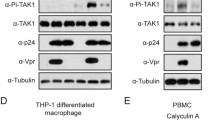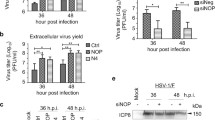Abstract
Herpes simplex virus 1 (HSV-1) is the archetypal member of the alphaherpesvirus with a large genome encoding over 80 viral proteins, many of which are involved in virus–host interactions and show immune modulatory capabilities. In this study, we demonstrated that the HSV-1 UL42 protein, a DNA polymerase processivity factor, was a novel antagonism of the canonical NF-κB signaling pathway. UL42 was shown to significantly suppress TNF-α mediated NF-κB activation. Co-immunoprecipitation experiment revealed that UL42 bound to the NF-κB subunits p65 and p50. Fluorescence microscopy demonstrated that UL42 abolished nuclear translocation of p65 and p50 upon TNF-α-stimulation. But the inhibiting capacity of UL42 2R/2A (R279A, R280A) and UL42 3R/3A (R113A, R279A and R280A) mutants were less than wild type UL42. Also UL42 bound to the Rel homology domain of the NF-κB subunit p65 and p50. Notably, the N-terminal of UL42 was sufficient to interact with p65 and p50 and abolished NF-κB reporter gene activity. Thus, it was first time we demonstrated that HSV-1 UL42 appeared to prevent NF-κB-dependent gene expression by retaining p65 and p50 in the cytoplasm, and UL42-dependent transcriptional activation were inherently coupled to promote HSV-1 lytic replication, which also may contribute to immune evasion and pathogenesis of HSV-1.







Similar content being viewed by others
References
Akira S, Uematsu S, Takeuchi O (2006) Pathogen recognition and innate immunity. Cell 124(4):783–801. doi:10.1016/j.cell.2006.02.015
Beutler B, Eidenschenk C, Crozat K, Imler JL, Takeuchi O, Hoffmann JA, Akira S (2007) Genetic analysis of resistance to viral infection. Nat Rev Immunol 7(10):753–766. doi:10.1038/nri2174
Medzhitov R (2007) Recognition of microorganisms and activation of the immune response. Nature 449(7164):819–826. doi:10.1038/nature06246
Koyama S, Ishii KJ, Coban C, Akira S (2008) Innate immune response to viral infection. Cytokine 43(3):336–341. doi:10.1016/j.cyto.2008.07.009
Oeckinghaus A, Ghosh S (2009) The NF-kappaB family of transcription factors and its regulation. Cold Spring Harb Perspect Biol 1(4):a000034. doi:10.1101/cshperspect.a000034
Ghosh S, May MJ, Kopp EB (1998) NF-kappa B and Rel proteins: evolutionarily conserved mediators of immune responses. Annu Rev Immunol 16:225–260. doi:10.1146/annurev.immunol.16.1.225
Li Q, Verma IM (2002) NF-kappaB regulation in the immune system. Nat Rev Immunol 2(10):725–734. doi:10.1038/nri910
Bonizzi G, Karin M (2004) The two NF-kappaB activation pathways and their role in innate and adaptive immunity. Trends Immunol 25(6):280–288. doi:10.1016/j.it.2004.03.008
Chen ZJ (2005) Ubiquitin signalling in the NF-kappaB pathway. Nat Cell Biol 7(8):758–765. doi:10.1038/ncb0805-758
Hayden MS, Ghosh S (2004) Signaling to NF-kappaB. Genes Dev 18(18):2195–2224. doi:10.1101/gad.1228704
Gilmore TD (2006) Introduction to NF-kappaB: players, pathways, perspectives. Oncogene 25(51):6680–6684. doi:10.1038/sj.onc.1209954
Baeuerle PA, Baltimore D (1996) NF-kappa B: ten years after. Cell 87(1):13–20
Baldwin AS Jr (1996) The NF-kappa B and I kappa B proteins: new discoveries and insights. Annu Rev Immunol 14:649–683. doi:10.1146/annurev.immunol.14.1.649
Leib DA (2002) Counteraction of interferon-induced antiviral responses by herpes simplex viruses. Curr Top Microbiol Immunol 269:171–185
Paladino P, Mossman KL (2009) Mechanisms employed by herpes simplex virus 1 to inhibit the interferon response. J Interferon Cytokine Res 29(9):599–607. doi:10.1089/jir.2009.0074
van Lint AL, Murawski MR, Goodbody RE, Severa M, Fitzgerald KA, Finberg RW, Knipe DM, Kurt-Jones EA (2010) Herpes simplex virus immediate-early ICP0 protein inhibits Toll-like receptor 2-dependent inflammatory responses and NF-kappaB signaling. J Virol 84(20):10802–10811. doi:10.1128/JVI.00063-10
Daubeuf S, Singh D, Tan Y, Liu H, Federoff HJ, Bowers WJ, Tolba K (2009) HSV ICP0 recruits USP7 to modulate TLR-mediated innate response. Blood 113(14):3264–3275. doi:10.1182/blood-2008-07-168203
Jin H, Ma Y, Yan Z, Prabhakar BS, He B (2012) Activation of NF-kappaB in CD8 + dendritic cells ex vivo by the gamma134.5 null mutant correlates with immunity against herpes simplex virus 1. J Virol 86(2):1059–1068. doi:10.1128/JVI.06202-11
Cotter CR, Kim WK, Nguyen ML, Yount JS, Lopez CB, Blaho JA, Moran TM (2011) The virion host shutoff protein of herpes simplex virus 1 blocks the replication-independent activation of NF-kappaB in dendritic cells in the absence of type I interferon signaling. J Virol 85(23):12662–12672. doi:10.1128/JVI.05557-11
Trego KS, Parris DS (2003) Functional interaction between the herpes simplex virus type 1 polymerase processivity factor and origin-binding proteins: enhancement of UL9 helicase activity. J Virol 77(23):12646–12659
Chaudhuri M, Parris DS (2002) Evidence against a simple tethering model for enhancement of herpes simplex virus DNA polymerase processivity by accessory protein UL42. J Virol 76(20):10270–10281
Randell JC, Komazin G, Jiang C, Hwang CB, Coen DM (2005) Effects of substitutions of arginine residues on the basic surface of herpes simplex virus UL42 support a role for DNA binding in processive DNA synthesis. J Virol 79(18):12025–12034. doi:10.1128/JVI.79.18.12025-12034.2005
Jiang C, Hwang YT, Randell JC, Coen DM, Hwang CB (2007) Mutations that decrease DNA binding of the processivity factor of the herpes simplex virus DNA polymerase reduce viral yield, alter the kinetics of viral DNA replication, and decrease the fidelity of DNA replication. J Virol 81(7):3495–3502. doi:10.1128/JVI.02359-06
Jiang C, Hwang YT, Wang G, Randell JC, Coen DM, Hwang CB (2007) Herpes simplex virus mutants with multiple substitutions affecting DNA binding of UL42 are impaired for viral replication and DNA synthesis. J Virol 81(21):12077–12079. doi:10.1128/JVI.01133-07
Xing J, Wang S, Li Y, Guo H, Zhao L, Pan W, Lin F, Zhu H, Wang L, Li M, Zheng C (2011) Characterization of the subcellular localization of herpes simplex virus type 1 proteins in living cells. Med Microbiol Immunol 200(1):61–68. doi:10.1007/s00430-010-0175-9
Jiang X, Takahashi N, Matsui N, Tetsuka T, Okamoto T (2003) The NF-kappa B activation in lymphotoxin beta receptor signaling depends on the phosphorylation of p65 at serine 536. J Biol Chem 278(2):919–926. doi:10.1074/jbc.M208696200
Severa M, Coccia EM, Fitzgerald KA (2006) Toll-like receptor-dependent and -independent viperin gene expression and counter-regulation by PRDI-binding factor-1/BLIMP1. J Biol Chem 281(36):26188–26195. doi:10.1074/jbc.M604516200
Schuhmann KM, Pfaller CK, Conzelmann KK (2011) The measles virus V protein binds to p65 (RelA) to suppress NF-kappaB activity. J Virol 85(7):3162–3171. doi:10.1128/JVI.02342-10
Mercurio F, Zhu H, Murray BW, Shevchenko A, Bennett BL, Li J, Young DB, Barbosa M, Mann M, Manning A, Rao A (1997) IKK-1 and IKK-2: cytokine-activated IkappaB kinases essential for NF-kappaB activation. Science 278(5339):860–866
Park KA, Byun HS, Won M, Yang KJ, Shin S, Piao L, Kim JM, Yoon WH, Junn E, Park J, Seok JH, Hur GM (2007) Sustained activation of protein kinase C downregulates nuclear factor-kappaB signaling by dissociation of IKK-gamma and Hsp90 complex in human colonic epithelial cells. Carcinogenesis 28(1):71–80. doi:10.1093/carcin/bgl094
Gao S, Song L, Li J, Zhang Z, Peng H, Jiang W, Wang Q, Kang T, Chen S, Huang W (2012) Influenza A virus-encoded NS1 virulence factor protein inhibits innate immune response by targeting IKK. Cell Microbiol. doi:10.1111/cmi.12005
Jordan M, Schallhorn A, Wurm FM (1996) Transfecting mammalian cells: optimization of critical parameters affecting calcium-phosphate precipitate formation. Nucleic Acids Res 24(4):596–601
Zhong B, Yang Y, Li S, Wang YY, Li Y, Diao F, Lei C, He X, Zhang L, Tien P, Shu HB (2008) The adaptor protein MITA links virus-sensing receptors to IRF3 transcription factor activation. Immunity 29(4):538–550. doi:10.1016/j.immuni.2008.09.003
Zhu H, Zheng C, Xing J, Wang S, Li S, Lin R, Mossman KL (2011) Varicella-zoster virus immediate-early protein ORF61 abrogates the IRF3-mediated innate immune response through degradation of activated IRF3. J Virol 85(21):11079–11089. doi:10.1128/JVI.05098-11
Xing J, Wang S, Lin F, Pan W, Hu CD, Zheng C (2011) Comprehensive characterization of interaction complexes of herpes simplex virus type 1 ICP22, UL3, UL4, and UL20.5. J Virol 85(4):1881–1886. doi:10.1128/JVI.01730-10
Xing J, Wu F, Pan W, Zheng C (2010) Molecular anatomy of subcellular localization of HSV-1 tegument protein US11 in living cells. Virus Res 153(1):71–81. doi:10.1016/j.virusres.2010.07.009
May MJ, Ghosh S (1997) Rel/NF-kappa B and I kappa B proteins: an overview. Semin Cancer Biol 8(2):63–73. doi:10.1006/scbi.1997.0057
Hu S, Sheng WS, Schachtele SJ, Lokensgard JR (2011) Reactive oxygen species drive herpes simplex virus (HSV)-1-induced proinflammatory cytokine production by murine microglia. J Neuroinflammation 8:123. doi:10.1186/1742-2094-8-123
Li H, Zhang J, Kumar A, Zheng M, Atherton SS, Yu FS (2006) Herpes simplex virus 1 infection induces the expression of proinflammatory cytokines, interferons and TLR7 in human corneal epithelial cells. Immunology 117(2):167–176. doi:10.1111/j.1365-2567.2005.02275.x
Seet BT, Johnston JB, Brunetti CR, Barrett JW, Everett H, Cameron C, Sypula J, Nazarian SH, Lucas A, McFadden G (2003) Poxviruses and immune evasion. Annu Rev Immunol 21:377–423. doi:10.1146/annurev.immunol.21.120601.141049
Patel A, Hanson J, McLean TI, Olgiate J, Hilton M, Miller WE, Bachenheimer SL (1998) Herpes simplex type 1 induction of persistent NF-kappa B nuclear translocation increases the efficiency of virus replication. Virology 247(2):212–222
Amici C, Belardo G, Rossi A, Santoro MG (2001) Activation of I kappa b kinase by herpes simplex virus type 1. A novel target for anti-herpetic therapy. J Biol Chem 276(31):28759–28766. doi:10.1074/jbc.M103408200
Taddeo B, Esclatine A, Roizman B (2002) The patterns of accumulation of cellular RNAs in cells infected with a wild-type and a mutant herpes simplex virus 1 lacking the virion host shutoff gene. Proc Natl Acad Sci U S A 99(26):17031–17036. doi:10.1073/pnas.252588599
Gregory D, Hargett D, Holmes D, Money E, Bachenheimer SL (2004) Efficient replication by herpes simplex virus type 1 involves activation of the IkappaB kinase-IkappaB-p65 pathway. J Virol 78(24):13582–13590. doi:10.1128/JVI.78.24.13582-13590.2004
Liu X, Fitzgerald K, Kurt-Jones E, Finberg R, Knipe DM (2008) Herpesvirus tegument protein activates NF-kappaB signaling through the TRAF6 adaptor protein. Proc Natl Acad Sci USA 105(32):11335–11339. doi:10.1073/pnas.0801617105
Roberts KL, Baines JD (2011) UL31 of herpes simplex virus 1 is necessary for optimal NF-kappaB activation and expression of viral gene products. J Virol 85(10):4947–4953. doi:10.1128/JVI.00068-11
Medici MA, Sciortino MT, Perri D, Amici C, Avitabile E, Ciotti M, Balestrieri E, De Smaele E, Franzoso G, Mastino A (2003) Protection by herpes simplex virus glycoprotein D against Fas-mediated apoptosis: role of nuclear factor kappaB. J Biol Chem 278(38):36059–36067. doi:10.1074/jbc.M306198200
Leoni V, Gianni T, Salvioli S, Campadelli-Fiume G (2012) Herpes simplex virus glycoproteins gH/gL and gB bind Toll-like receptor 2, and soluble gH/gL is sufficient to activate NF-kappaB. J Virol 86(12):6555–6562. doi:10.1128/JVI.00295-12
Acknowledgments
This work was supported by grants from the Major State Basic Research Development Program of China (973 Program) (2011CB504800 and 2010CB530100); the Start-up Fund of the Hundred Talents Program of the Chinese Academy of Sciences (20071010-141); the National Natural Science Foundation of China (81171584). We thank Dr. Rao Anjana (Immune Disease Institute, Harvard Medical School), and Dr. Gangmin Hur (Chungnam National University) for providing plasmids.
Author information
Authors and Affiliations
Corresponding author
Electronic supplementary material
Below is the link to the electronic supplementary material.
430_2013_295_MOESM1_ESM.tif
Fig S1. UL42 inhibits TRAF2, RIP1, NIK, IKKα-induced NF-κB Activity. The HEK 293T cells were co-transfected with NF-κB-Luc, pRL-TK and TRAF2 (A), RIP1 (B), NIK (C), IKKα and (D) expression plasmids along with indicated amount of UL42 expression plasmid. Luciferase activity was analyzed as described in Fig. 1A. Cell lysates were analyzed by immunoblotting (IB) with tag-specific Abs (bottom panels) to detect the expression of Flag-TRAF2, Flag-TAK1 and HA-IKKα. The UL42 expression was detected by anti-HA mAb. IB of β-actin was used to verify equal loading of protein in each lane. The data represent means plus standard deviations for three replicates. Statistical analysis was performed using Student’s t test. **, P < 0.01. (TIFF 1338 kb)
430_2013_295_MOESM2_ESM.tif
Fig S2. UL42(1-390aa) interacts with p65 and p50. The HEK 293T cells were transfected with UL42(1-390aa)-Flag expression plasmid. At 24 h after transfection, cells harvested and lysed, the samples were then subjected to immunoprecipitation assays using anti-p65 pAb (IP: p65), anti-p50 pAb (IP: p50) or control antibody IgG. Immunoprecipitated samples (IP) were separated by 10 % SDS-PAGE, and proteins were transferred onto a PVDF membrane. IB was probed with the indicated Ab. (TIFF 497 kb)
Rights and permissions
About this article
Cite this article
Zhang, J., Wang, S., Wang, K. et al. Herpes simplex virus 1 DNA polymerase processivity factor UL42 inhibits TNF-α-induced NF-κB activation by interacting with p65/RelA and p50/NF-κB1. Med Microbiol Immunol 202, 313–325 (2013). https://doi.org/10.1007/s00430-013-0295-0
Received:
Accepted:
Published:
Issue Date:
DOI: https://doi.org/10.1007/s00430-013-0295-0




